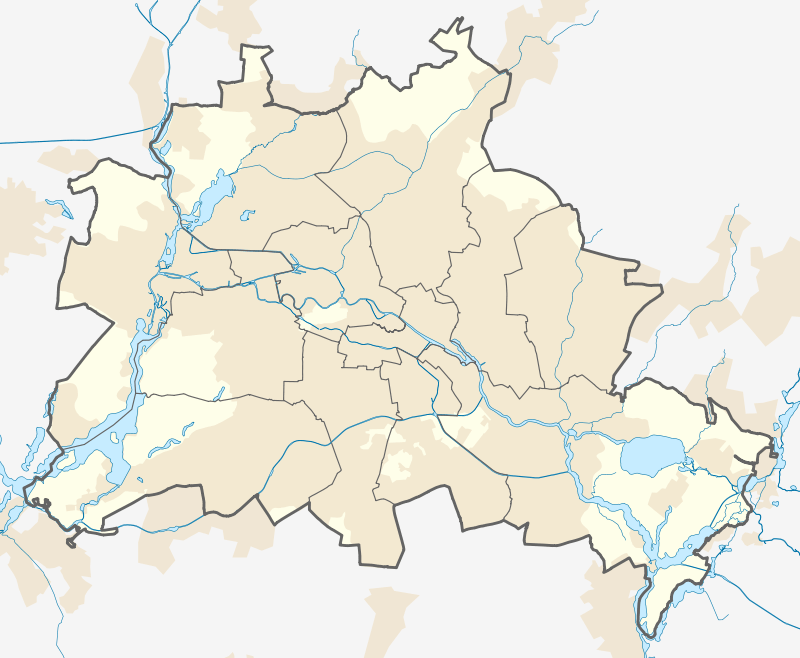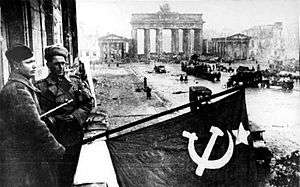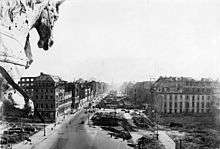Hotel Adlon
| Hotel Adlon | |
|---|---|
.jpg) The current Hotel Adlon Kempinski Berlin | |
 Location in Berlin | |
| Hotel chain | Kempinski |
| General information | |
| Location | Berlin–Mitte, Germany |
| Address | Unter den Linden 77 |
| Coordinates | 52°30′57.77″N 13°22′49.70″E / 52.5160472°N 13.3804722°E |
| Opening |
original hotel 24 October 1907 (current hotel 23 August 1997) |
| Technical details | |
| Floor count | 7 |
| Design and construction | |
| Architect | Rainer Michael Klotz |
| Other information | |
| Number of rooms | 382 |
| Number of restaurants | 4 |
| Number of bars | 5 |
| Website | |
| www.kempinski.com/adlon | |
The Hotel Adlon Kempinski Berlin is a luxury hotel in Berlin, Germany. It is located on Unter den Linden, the main boulevard in the central Mitte district, at the corner with Pariser Platz, directly opposite the Brandenburg Gate and the Memorial to the Murdered Jews of Europe.
The legendary original Hotel Adlon was one of the most famous hotels in Europe. It opened in 1907 and was largely destroyed in 1945 in the closing days of World War II, though a small wing continued operating until 1984. The current hotel, which opened on August 23, 1997, is a new building with a design inspired by the original.
History
First Hotel Adlon
In the late 19th century, European hotels, which generally offered no more than overnight accommodation, evolved to become social gathering places which could host large receptions given by nobility and the wealthy. Modeled on American hotels like the Waldorf Astoria, new hotel buildings arose all over the continent with lavishly decorated ballrooms, dining halls, arcades, smoking lounges, libraries, and coffeehouses. In 1873 the Hotel Imperial opened in Vienna, followed by the Hôtel Ritz Paris in 1898, and The Ritz London Hotel in 1906. In Berlin, capital of the German Empire the Wilhelmine high society was eager to keep up with their rival metropolises.

In 1905 Lorenz Adlon, a successful wine merchant and restaurateur originally from Mainz, purchased two properties on Unter den Linden. Adlon ran several coffeehouses in Berlin, among others in the Berlin Zoological Garden, and had raised capital to build a hotel on Pariser Platz, at the heart of the German capital. He convinced Kaiser Wilhelm II that Berlin needed a luxury hotel at the level of those in Paris, London and the other European capitals, and so the Kaiser personally interceded with the owners of the Palais Redern, a Neo-Renaissance landmark designed by Karl Friedrich Schinkel in 1830, which sat at Adlon's chosen location. The Kaiser cleared the way for Adlon's purchase of the Palais and for the subsequent demolition of the historic building.
Designed by Carl Gause and Robert Leibnitz, the hotel was built at a cost of 20 Million Gold Marks, 2 Million of which were the majority of Adlon's personal fortune. Behind a rather sober façade, the hotel was the most modern in Germany with hot and cold running water, an on-site laundry, as well as its own power plant to generate electricity. It boasted a huge lobby with enormous square marble columns, a restaurant, a cafe, a palm court, a ladies' lounge, a library, a music room, a smoking room, a barber shop, a cigar shop, an interior garden with a Japanese-themed elephant fountain, and numerous grand ballrooms. The hotel was decorated in a mix of Neo-Baroque and Louis XVI styles and furnished by the Mainz company of Bembé, where Lorenz Adlon had been an apprentice carpenter in his youth. It was located in the heart of the government quarter next to the British Embassy on Wilhelmstrasse, facing the French and American Embassies on Pariser Platz and only blocks from the Reich Chancellery and other government ministries further south on Wilhelmstrasse.

The Adlon opened on October 23, 1907 with the Kaiser, his wife, and many other notables in attendance. It quickly became the social center of Berlin. As the rooms in the Stadtschloss were cold and drafty, the Kaiser paid an annual retainer to keep suites available for his guests.[1] Likewise the Foreign Office used the Adlon for accommodation during state visits, with guests including Tsar Nicholas II of Russia and Maharaja Bhupinder Singh of Patiala. Notable guests of the early years included industrialists such as Thomas Edison, Henry Ford, and John D. Rockefeller, as well as politicians like Walter Rathenau, Gustav Stresemann and the French prime minister Aristide Briand. Many wealthy Berliners lived for extended periods of time in the hotel, while its ballrooms hosted official government functions and society events.
After World War I and the abdication of the Kaiser, Lorenz Adlon remained a staunch monarchist and thus never imagined normal traffic would pass through the Brandenburg Gate's central archway, which had been reserved for the Kaiser alone. He therefore never looked before crossing in front of it. Tragically, this resulted in Adlon being hit by a car in 1918 at that spot. Three years later, on April 7, 1921, he was again hit by a car at exactly the same spot, this time fatally. Lorenz's son Louis Adlon took over management of the hotel with his wife Hedda, who was German-born but had been raised in America. During the "Golden Twenties", the Adlon remained one of the most famous hotels in Europe, hosting celebrity guests including Louise Brooks, Charlie Chaplin, Mary Pickford, Emil Jannings, Albert Einstein, Enrico Caruso, Thomas Mann, Josephine Baker, and Marlene Dietrich, and also politicians like Franklin Roosevelt, Paul von Hindenburg, and Herbert Hoover. The hotel was a favorite hangout of international journalists, including William L. Shirer, who mentions it frequently in his writings.

The hotel remained a social center of the city throughout the Nazi period, though the Nazis themselves preferred the Hotel Kaiserhof a few blocks south and directly across from the Propaganda Ministry and Hitler's Chancellery on Wilhelmplatz. The Adlon continued to operate normally throughout World War II, even constructing a luxurious bomb shelter for its guests and a huge brick wall around the lobby level to protect the function rooms from flying debris. Parts of the hotel were converted to a military field hospital during the final days of the Battle of Berlin. The hotel survived the war without any major damage, having avoided the bombs and shelling that had leveled the city. However, on the night of May 2, 1945 a fire, started in the hotel's wine cellar by drunken Red Army soldiers, left the main building in ruins.
Louis Adlon himself was arrested in his home near Potsdam by Soviet troops on April 25 after they mistook him for a general due to his title of "Generaldirektor". He died on a street in Falkensee on May 7, 1945, of cardiac insufficiency according to the death certificate.[2]
East German Hotel Adlon

Following the war, the East German government reopened the building's surviving rear service wing under the Hotel Adlon name. The ruined main building was demolished in 1952, along with all of the other buildings on Pariser Platz. The square was left as an abandoned, grassed-over buffer with the West, with the Brandenburg Gate sitting alone by the Berlin Wall.
In 1964, the remaining part of the building was renovated and the facade was redone. However, in the 1970s what remained of the original Hotel Adlon closed to guests and was converted to serve mainly as a lodging house for East German apprentices. Finally, in 1984, the building was demolished.
Second Hotel Adlon Kempinski

With the reunification of Germany, the site was bought by a West German investment firm and a new hotel was built between 1995 and 1997. The building, only very loosely inspired by the original, was designed by Rainer Michael Klotz of Patzschke Klotz & Partners, and on August 23, 1997 German President Roman Herzog opened the new Hotel Adlon. The hotel occupies the site of the original building, along with additional adjacent land. It currently operates as Hotel Adlon Kempinski Berlin, part of the Kempinski chain. Due to the hotel's success, it has been expanded twice with new wings at the rear on Behrenstrasse. The first wing, known as the Adlon Palais, opened in 2003, while the second, known as the Adlon Residenz, opened in 2004.
The Adlon was expanded with a six-story glass wing designed by German architect Günter Behnisch, meant to house the Academy of Arts, Berlin and other mixed-use spaces.[3][4]
Location
The original Hotel Adlon was famously located at Number One Unter Den Linden, as the avenue was numbered starting at the Brandenburg Gate end. However, in the East German era, the avenue was renumbered, starting from the other end. As a result, the current Hotel Adlon Kempinski's entrance, though located at exactly the same site, is now at Unter den Linden 77.
In popular culture

- Film director Percy Adlon is the great-grandson of Lorenz Adlon and made a documentary about the hotel called The Glamorous World of the Adlon Hotel in 1996.
- Hedda Adlon's 1955 autobiography, Hotel Adlon. Das Berliner Hotel, in dem die große Welt zu Gast war, was published in English in 1960 as Hotel Adlon: The Life and Death of a Great Hotel.
- Hedda's book was filmed in German in 1955 as Hotel Adlon by director Josef von Báky, starring Nelly Borgeaud.
- Much of the Liam Neeson action film Unknown was filmed at the Adlon, including the final portion.
- Greta Garbo's 1932 film Grand Hotel is set in a Berlin hotel inspired by the Adlon. In one of its rooms, she first utters her trademark line 'I want to be alone'.
- A fictional half-ruined pre-war luxury hotel in East Berlin (also inspired by the Adlon), is seen in Billy Wilder's film One, Two, Three.
- The hotel features prominently in numerous fiction and non-fiction books about the Third Reich, including Joseph Kanon's novel The Good German, Philip Kerr's Bernie Gunther novels, David Downing's John Russell novels, and William L. Shirer's memoir Berlin Diary.
- Michael Jackson dangled his then-infant son "Blanket" out one of the hotel's windows during a visit to Berlin in November 2002. He apologized afterward saying "I offer no excuses for what happened, I got caught up in the excitement of the moment. I would never intentionally endanger the lives of my children."
- In the 1972 film Cabaret, Liza Minnelli's character Sally Bowles says she went to "the Adlon" to meet her father, who did not show up.
- The hotel appears as a still photograph in the intro for Heil Honey, I'm Home!, a 1990 British sitcom starring Adolf Hitler and Eva Braun that was canceled after one episode for being in bad taste.
- In the Doctor Who episode "Let's Kill Hitler", the TARDIS lands in the dining room of the Hotel Adlon in 1938, the Doctor dies there due to River Song's poisonous kiss and she uses her own regeneration energy plus all her future regenerations to resurrect the Doctor, under the eyes of Amy Pond and Rory Williams.
- A three-part drama mini-series set at the hotel entitled Das Adlon. Eine Familiensaga (The Adlon: A Family Saga) was broadcast on the German television station ZDF in January 2013.
- A documentary Das Adlon – Die Dokumentation (The Adlon: A Documentary) was also broadcast by ZDF in January 2013.
Gallery
- Hotel Adlon
 Hotel Adlon, 1927
Hotel Adlon, 1927
 Berlin, Hotel Adlon at center, 1931
Berlin, Hotel Adlon at center, 1931 Louis Adlon in his office, 1932
Louis Adlon in his office, 1932 Funeral of German Foreign Minister Gustav Stresemann, October 6, 1929
Funeral of German Foreign Minister Gustav Stresemann, October 6, 1929 French Premier Pierre Laval and Foreign Minister Aristide Briand at the Adlon, September 1, 1931
French Premier Pierre Laval and Foreign Minister Aristide Briand at the Adlon, September 1, 1931 Foreign Press Ball at the Adlon, c. 1930s
Foreign Press Ball at the Adlon, c. 1930s Thomas Mann at the Adlon, 1929
Thomas Mann at the Adlon, 1929 Thomas Mann at the Adlon, 1929
Thomas Mann at the Adlon, 1929 Jackie Coogan at the Adlon, 1924
Jackie Coogan at the Adlon, 1924 Jackie Coogan at the Adlon, 1924
Jackie Coogan at the Adlon, 1924 Jackie Coogan at the Adlon, 1924
Jackie Coogan at the Adlon, 1924 Hotel Adlon ruins, 1950, showing the protective wall built around the ground floor in the closing months of World War II
Hotel Adlon ruins, 1950, showing the protective wall built around the ground floor in the closing months of World War II The ruined main entrance to the Hotel Adlon, 1950
The ruined main entrance to the Hotel Adlon, 1950 Ruined courtyard of the Adlon, 1950
Ruined courtyard of the Adlon, 1950 Entrance to the makeshift Hotel Adlon through the surviving service wing on Wilhelmstrasse, 1950
Entrance to the makeshift Hotel Adlon through the surviving service wing on Wilhelmstrasse, 1950 Hotel Adlon site before construction began, 1990
Hotel Adlon site before construction began, 1990- Hotel Adlon Kempinski, 2011
.jpg) Adlon Palais, facing Behrenstrasse, 2011
Adlon Palais, facing Behrenstrasse, 2011
 Hotel Adlon in April 2012
Hotel Adlon in April 2012- Business room at Hotel Adlon. April 2012.
References
- ↑ http://www.historichotelsthenandnow.com/hotels/europe/germany/hotel-adlon-kempinski-berlin/
- ↑ Article in German newspaper
- ↑ "architect Günter Behnisch dies at 88 years". die Welt (German language). Retrieved 3 November 2016.
- ↑ "Front history, rear Behnisch The Hotel Adlon in Berlin is extended". BauNetz (German language). Retrieved 3 November 2016.
External links
| Wikimedia Commons has media related to Hotel Adlon. |
- Hotel Adlon Kempinski Berlin official website
- Percy Adlon's "The Glamorous of the Adlon Hotel, An homage to my own family"
- "In der glanzvollen Welt des Hotel Adlon" – IMDb
Coordinates: 52°30′57″N 13°22′50″E / 52.51583°N 13.38056°E
- Information on Berlin Hotels - Hotel Adlon
- The Luftfaus rocket system outside Hotel Adlon - MilitaryImages.Net